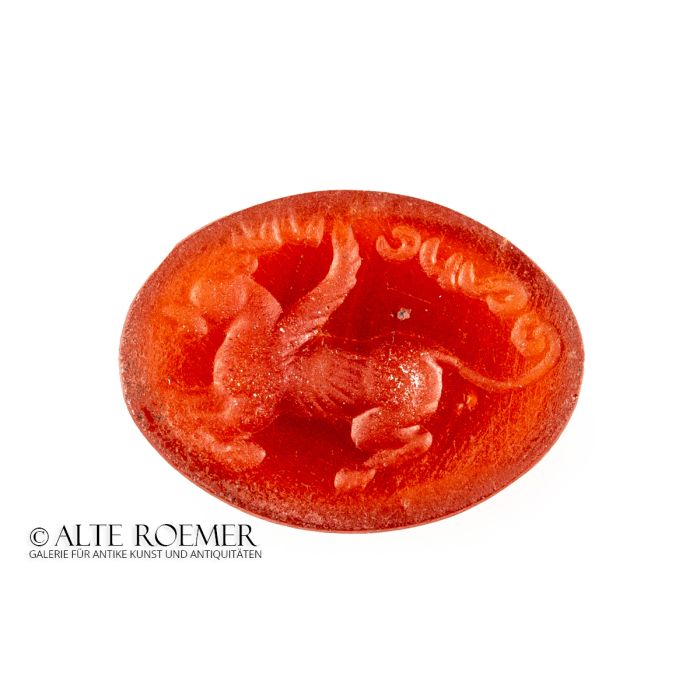Sassanian intaglio with griffin
Price: on request
Sold
Object number
AR3225
| Object: |
Sassanian intaglio with griffin
|
| Material: |
Dark orange stone. Carnelian.
|
| Period: |
224 AD to 651 AD, period of Sasanian rule, Late Antiquity. |
| Description: |
Sassanian intaglio of clear, dark orange stone, with a flat surface and tapered sides. The stone is engraved in great detail and shows a winged hybrid creature, a griffin. It has the body of a lion and stands with bent legs, long wings on its back. The head resembles a bird. Above the animal is an inscription in Pahlavi, the Middle Persian script of the Sassanids.
|
| Background: |
The Sassanids became the dominant power in the Near East after their conquest against the Parthians in 220 AD and remained so until the Arab conquest in 642 AD, or politically until the death of the last King Yazdegerd III in 651 AD. This second Persian empire spanned much of modern-day Iran and Iraq, expanding its cultural and economic influence throughout the Near East. The religion of the Sassanids was Zoroastrianism, which is based on the teachings of Zarathustra (Greek spelling Zoroaster). This is still reflected today in a variety of ways in the surviving artefacts, especially in the coins and seals. Sasanian stamp seals usually had an ellipsoidal shape and an engraved stamping area. Stones that shimmered through turned the seals into small pieces of jewellery. The typical large loop hole of the seal made it possible to wear it on elaborate chains or on simple ribbons. The relatively large number of pieces that survived to this day suggests that many people once possessed these seals. Important collections can be found in the major museums (e.g. the Berlin State Museums, the British Museum) as well as in private hands (the Anavian Collection). Researchers disagree on the exact dating and typification of Sasanian seals. Coins from this period are only suitable for a comparison to a limited extent, as there are uncertainties in their dating. The excavation finds are not numerous enough to work out a typology. Since the typical pictorial representation of the seals did not correspond to Islamic culture, the art of seal cutting quickly disappeared after the Arab conquest and the Sassanid culture fell into oblivion. |
| Dimensions: |
17,5mm x 13mm.
|
| Condition: |
Perfectly preserved. Worthy to be displayed at a museum.
|
| Provenance: |
Acquired by us in 2021 from Gerhard Hirsch Nachfolger, Munich, Germany. The object was in the Gerhard Hirsch auction 171 anno 1991, lot no. 1998, and came into possession of the auction house subsequently.
2021 durch uns von Gerhard Hirsch Nachfolger, München erworben. Das Objekt befand sich in der Gerhard Hirsch Auktion 171 von 1991, Losnr. 1998, und ging dann in den Bestand des Auktionshauses über.
|
| References: |
Cf. R. Goebl, Der Sasanidische Siegelkanon, plate 25, no. 67c for the motif and plate 40, no. 1 for the seal shape.
|
| Literature: |
Kurt Erdmann, Die Kunst Irans zur Zeit der Sasaniden (1943).
|
| Authenticity: |
We unconditionally guarantee the authenticity of every artefact, all items are subject to our lifetime return policy on authenticity.
|


